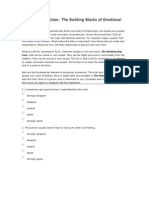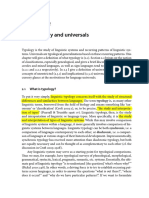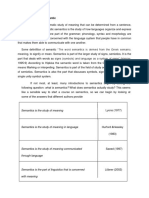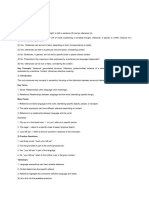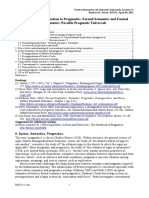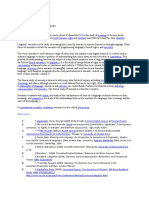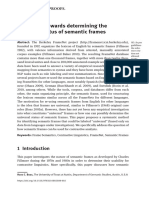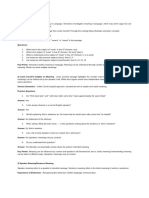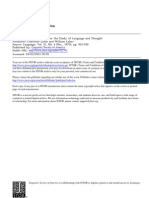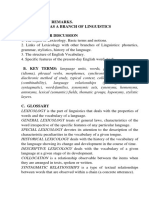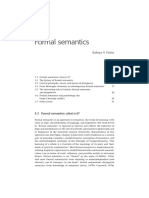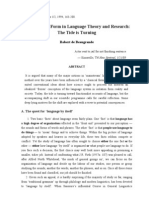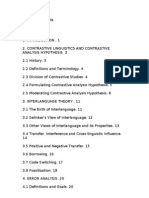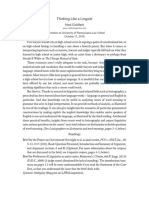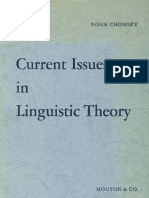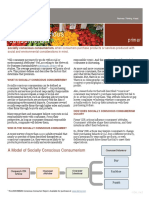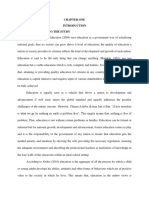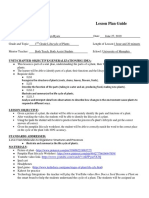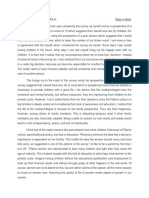100%(1)100% found this document useful (1 vote)
132 viewsSemantics, Pragmatics, and Meaning
Semantics, Pragmatics, and Meaning
Uploaded by
smhmdThis document provides introductory definitions and discussions around the concepts of meaning, semantics, and pragmatics. It begins by asking the reader to consider the meanings of various words and discusses how meaning is complex, depending on context, individuals, and societies. Semantics is defined as the study of meaning and word relations, though meanings are not stable and depend on speakers, hearers, and context. Pragmatics is concerned with understanding language in both linguistic and situational contexts. The document provides several references for further reading.
Copyright:
© All Rights Reserved
Available Formats
Download as PDF, TXT or read online from Scribd
Semantics, Pragmatics, and Meaning
Semantics, Pragmatics, and Meaning
Uploaded by
smhmd100%(1)100% found this document useful (1 vote)
132 views1 pageThis document provides introductory definitions and discussions around the concepts of meaning, semantics, and pragmatics. It begins by asking the reader to consider the meanings of various words and discusses how meaning is complex, depending on context, individuals, and societies. Semantics is defined as the study of meaning and word relations, though meanings are not stable and depend on speakers, hearers, and context. Pragmatics is concerned with understanding language in both linguistic and situational contexts. The document provides several references for further reading.
Original Description:
Semantics, pragmatics, and meaning definitions from Prof. Berjaoui of the University of Ibn Tofail.
Original Title
Semantics, pragmatics, and meaning
Copyright
© © All Rights Reserved
Available Formats
PDF, TXT or read online from Scribd
Share this document
Did you find this document useful?
Is this content inappropriate?
This document provides introductory definitions and discussions around the concepts of meaning, semantics, and pragmatics. It begins by asking the reader to consider the meanings of various words and discusses how meaning is complex, depending on context, individuals, and societies. Semantics is defined as the study of meaning and word relations, though meanings are not stable and depend on speakers, hearers, and context. Pragmatics is concerned with understanding language in both linguistic and situational contexts. The document provides several references for further reading.
Copyright:
© All Rights Reserved
Available Formats
Download as PDF, TXT or read online from Scribd
Download as pdf or txt
100%(1)100% found this document useful (1 vote)
132 views1 pageSemantics, Pragmatics, and Meaning
Semantics, Pragmatics, and Meaning
Uploaded by
smhmdThis document provides introductory definitions and discussions around the concepts of meaning, semantics, and pragmatics. It begins by asking the reader to consider the meanings of various words and discusses how meaning is complex, depending on context, individuals, and societies. Semantics is defined as the study of meaning and word relations, though meanings are not stable and depend on speakers, hearers, and context. Pragmatics is concerned with understanding language in both linguistic and situational contexts. The document provides several references for further reading.
Copyright:
© All Rights Reserved
Available Formats
Download as PDF, TXT or read online from Scribd
Download as pdf or txt
You are on page 1of 1
Ibn Tofail University-Faculty of Letters and Human Sciences-Department of English-The English Studies Unit-Kénitra-
Semester 6 (S 6) Semantics and Pragmatics- Introductory backgrounds -H 2-Professor Berjaoui-2020
1) Contents
Introductory backgrounds (the notion of “meaning(s)”, semantics, and pragmatics)
2) Meaning(s)
a) Read “Man’s Search for Meaning”. Watch “Waiting for Godot”.
b) Discuss the meaning(s) of the following words: God, life, death, family, studies, job, love, war, tree, and
freedom.
3) Meaning: tentative definitions
a) “The term ‘meaning’ is, of course, much more familiar to us all. But the dictionary will suggest a number of
different meanings of ‘meaning’.” (Palmer, 1981: 3).
b) The “meaning of a word, phrase, or text (…).” (http://oxforddictionaries.com).
c) “No one has yet produced a satisfactory answer to it.” (Lyons, 1981: 136).
4) Meaning: selected remarks
Meaning is too general to discuss and treat in one word or work. Meaning is conventional. Meaning is
individual. Meaning goes beyond the word level. Meaning transcends the sentence level. Meaning may require a
whole dialogue/text. Meaning depends on society. Meaning depends on the individual. Meaning depends on shared
background. Meaning changes. Meaning is the essence of communication. Meaning depends on the nature of the
word(s). Meaning depends on the words positions in the sentence. Meaning depends on the relation between words in
the sentence. Meaning depends on the “real world”. Meaning is diverse.
5) Semantics: definitions
a) It is “the branch of linguistics (…) concerned with matters such as sense and reference (…) and implication
(…).”(http://oxforddictionaries.com).
b) It is “concerned with the analysis of word meanings and relations between them.”
(http://oxforddictionaries.com).
c) We “can assume that semantics is a component or level of linguistics of the same kind as phonetics (…).”
(Palmer, 1981: 5).
d) “Semantics is the study of meaning.” (Lyons, 1981: 136).
e) “Semantics traditionally deals with meaning as a dyadic relation, as (…) ‘What does X mean?’” (Palmer,
1981: 6).
f) “A further difficulty with semantics is that meanings do not seem to be stable but to depend upon speakers,
hearers and context.” (Palmer, 1981: 7).
g) “It is not at all clear what constitutes evidence for a statement about meaning, and some of the theories that
have laid most claims to being scientific have proved to be the most unsatisfactory. Precisely what is meant by
‘scientific’ or ‘empirical’ in the context of linguistic study is a matter of some debate.” (Palmer, 1981: 6-7).
6) Pragmatics: definitions
“Pragmatics is concerned with our understanding of language in context. Two kinds of contexts are relevant.
The first is linguistic context —the discourse that precedes the phrase or sentence to be interpreted; the second is
situational context —virtually everything nonlinguistic in the environment of the speaker.” (Fromkin et al., 2011:
207).
7) References
a) Fromkin, Victoria et al. (2011). An Introduction to Language. Ninth edition. Boston: Wadsworth Cengage
Learning.
b) Leech, Geoffrey (1974). Semantics. Harmondsworth: Penguin.
c) Leech, Geoffrey (1983). Principles of Pragmatics. New York: Longman.
d) Levinson C. Stephen (1983). Pragmatics. Cambridge: Cambridge University Press.
e) Lyons, John (1977). Semantics, Volume I. Cambridge: Cambridge University Press.
f) Lyons, John (1977). Semantics, Volume II. Cambridge: Cambridge University Press.
g) Lyons, John (1981). Language and Linguistics: An Introduction. Cambridge: Cambridge University Press.
h) Palmer, Frank Robert (1981). Semantics. Cambridge: Cambridge University Press.
i) http://oxforddictionaries.com/definition/english/run?q=run.
You might also like
- Bids For Connection Quiz - GottmanDocument4 pagesBids For Connection Quiz - GottmanHollie123086% (7)
- Hand Washing Lesson PlanDocument10 pagesHand Washing Lesson PlanADI100% (1)
- J Pustejovsky Lexical Semantics Overview 1Document11 pagesJ Pustejovsky Lexical Semantics Overview 1abresesamoNo ratings yet
- Compassionate Imagery PaperDocument10 pagesCompassionate Imagery PaperanamosenaNo ratings yet
- SemanticsDocument69 pagesSemanticsYusuf Iro Husodo100% (2)
- Velupillai 2012 ch2Document5 pagesVelupillai 2012 ch2elliroussNo ratings yet
- A. Definition of Semantic: Semantics Is The Study of MeaningDocument6 pagesA. Definition of Semantic: Semantics Is The Study of MeaningadindaNo ratings yet
- Discourse Analysis: Mr. Trương Văn ÁnhDocument29 pagesDiscourse Analysis: Mr. Trương Văn ÁnhBich Huyen PhamNo ratings yet
- (Grammar) Meaning (Semantics Pragmatics) Morphology Words) Syntax Phrases Sentences) PhonologyDocument11 pages(Grammar) Meaning (Semantics Pragmatics) Morphology Words) Syntax Phrases Sentences) PhonologyFitraAshari100% (1)
- 8Document6 pages8machristobono3No ratings yet
- 2006 FormalsemanticsDocument16 pages2006 Formalsemanticsmahamerua45No ratings yet
- Chapter 3.Document8 pagesChapter 3.ai4238973No ratings yet
- Nature of Meaning PDFDocument6 pagesNature of Meaning PDFMarivic macabuhayNo ratings yet
- MGU1111Document14 pagesMGU1111EFEAFADNo ratings yet
- Polysemy in Traditional vs. Cognitive LinguisticsDocument17 pagesPolysemy in Traditional vs. Cognitive LinguisticsyazadnNo ratings yet
- Group I Semantics (Basic Ideas) - DikonversiDocument7 pagesGroup I Semantics (Basic Ideas) - DikonversiRijal QalbiNo ratings yet
- The Pragmatic Interpretation of Utterances: 1 Meaning: Semantics Versus PragmaticsDocument14 pagesThe Pragmatic Interpretation of Utterances: 1 Meaning: Semantics Versus Pragmaticsمحمد سعدNo ratings yet
- SemanticsDocument10 pagesSemanticsHadrowi Dwi Putra RapikNo ratings yet
- Dialectic ADocument16 pagesDialectic AAnonymous 1C8UBLANo ratings yet
- NNHDC Chapter 6 DiscourseDocument25 pagesNNHDC Chapter 6 DiscourseYoloNo ratings yet
- Group 5 (Sentential Meaning) - 1Document11 pagesGroup 5 (Sentential Meaning) - 1QoriNo ratings yet
- Test For ExamDocument8 pagesTest For ExamIlona YakovynaNo ratings yet
- SemanticsDocument9 pagesSemanticsgoblin7708No ratings yet
- Boas 2020 Universal Frames Uncorrected ProofsDocument32 pagesBoas 2020 Universal Frames Uncorrected Proofsedu mirNo ratings yet
- Encycloped ArticleDocument7 pagesEncycloped ArticleAlberto EarnshawNo ratings yet
- About SemanticsDocument8 pagesAbout Semanticsai4238973No ratings yet
- Uts RLT BDocument2 pagesUts RLT BHonesty TrilaNo ratings yet
- 8-Semantics Chapter 1 Last VersionDocument9 pages8-Semantics Chapter 1 Last VersionAYOUB ESSALHINo ratings yet
- The Case For Case - FillmoreDocument109 pagesThe Case For Case - FillmoreEilineckNo ratings yet
- SemanticsDocument3 pagesSemanticsIshaqNo ratings yet
- Linguistic Society of AmericaDocument17 pagesLinguistic Society of AmericaKayssia VenstarNo ratings yet
- Aditya Ahmad Farizqi (190511100054) Contrastive Analysis AssignmentDocument4 pagesAditya Ahmad Farizqi (190511100054) Contrastive Analysis AssignmentAditya AhmadNo ratings yet
- Семінарські Заняття ЛК 1Document39 pagesСемінарські Заняття ЛК 1Соня ГалійNo ratings yet
- Barbara H. Partee - Formal SemanticsDocument30 pagesBarbara H. Partee - Formal SemanticsSamet Erişkin (samterk)No ratings yet
- Introduction To SemanticsDocument4 pagesIntroduction To SemanticsMuahmmedNo ratings yet
- Semantics As A Study of Meaning. How Do Words Acquire Meaning? Linguistic Semantics Looks at The Way An Individual Language Structures The World ForDocument5 pagesSemantics As A Study of Meaning. How Do Words Acquire Meaning? Linguistic Semantics Looks at The Way An Individual Language Structures The World ForНадія Лупій100% (1)
- Recursion and The Infinitude ClaimDocument25 pagesRecursion and The Infinitude ClaimGuaguanconNo ratings yet
- Current Approaches To MetaphorDocument25 pagesCurrent Approaches To MetaphorAndrew MulliganNo ratings yet
- Context esra & rahmaDocument8 pagesContext esra & rahmaAlice A.No ratings yet
- MID SemanticsDocument3 pagesMID SemanticsNurul LimNo ratings yet
- Lang Handout 6Document3 pagesLang Handout 6Hassan MirNo ratings yet
- Seeking The Nature of IdiomsDocument30 pagesSeeking The Nature of Idiomsnemrak88No ratings yet
- Beau Grande Form+FunctionDocument29 pagesBeau Grande Form+FunctionmjweiningerNo ratings yet
- Deep StructureDocument9 pagesDeep StructureLoreinNo ratings yet
- Intro 1Document4 pagesIntro 1Linh Nguyễn thị khánhNo ratings yet
- Discourse AnalysisDocument214 pagesDiscourse Analysisanhnguyen4work100% (1)
- Contrastive Linguistics and Contrastive Analysis HypothesisDocument44 pagesContrastive Linguistics and Contrastive Analysis HypothesisKhawla Adnan63% (8)
- Greek and The Study of LanguageDocument18 pagesGreek and The Study of LanguageHibaalgurjiaNo ratings yet
- 72nd Inaugural Lecture Prof Nwaozuzu The Babalist Theory of MeaningDocument57 pages72nd Inaugural Lecture Prof Nwaozuzu The Babalist Theory of MeaningMaureen Jhaque GensayaNo ratings yet
- A Socio-Semiotic Approach To Meaning in Translation: Ke PingDocument10 pagesA Socio-Semiotic Approach To Meaning in Translation: Ke PingYasser SaidNo ratings yet
- TYLER and EVANS - 2004 - Applying Cognitive Linguistics To Pedagogical Grammar - The Case of OverDocument24 pagesTYLER and EVANS - 2004 - Applying Cognitive Linguistics To Pedagogical Grammar - The Case of OverSu EsNo ratings yet
- Thinking Like A LinguistDocument6 pagesThinking Like A LinguistnealgoldfarbNo ratings yet
- Philosophy of LanguageDocument7 pagesPhilosophy of LanguageAkash KumarNo ratings yet
- Hayes Introductory Linguistics 2010Document451 pagesHayes Introductory Linguistics 2010hangadrottinNo ratings yet
- Preguntas Análisis Del DiscursoDocument9 pagesPreguntas Análisis Del DiscursoLaura Gabardino SánchezNo ratings yet
- 7 (1) (1) - Semantic OrganizationDocument6 pages7 (1) (1) - Semantic OrganizationflorygheNo ratings yet
- Current Issues in Linguistic Theory 5th Printing Janua Linguarum Series Minor 38Document119 pagesCurrent Issues in Linguistic Theory 5th Printing Janua Linguarum Series Minor 38Abdelhalim Aounali100% (6)
- Linguistic modality in Shakespeare Troilus and Cressida: A casa studyFrom EverandLinguistic modality in Shakespeare Troilus and Cressida: A casa studyNo ratings yet
- Meaning and Saying: Essays in the Philosophy of Language: Second EditionFrom EverandMeaning and Saying: Essays in the Philosophy of Language: Second EditionNo ratings yet
- Philosophy of Language: The Classics ExplainedFrom EverandPhilosophy of Language: The Classics ExplainedRating: 3 out of 5 stars3/5 (1)
- Philosophical Essays, Volume 1: Natural Language: What It Means and How We Use ItFrom EverandPhilosophical Essays, Volume 1: Natural Language: What It Means and How We Use ItNo ratings yet
- Conceptual Integration Theory in Idiom ModificationsFrom EverandConceptual Integration Theory in Idiom ModificationsNo ratings yet
- Singaporean Culture - Core Concepts: 6-8 MinutesDocument5 pagesSingaporean Culture - Core Concepts: 6-8 Minutesdavid_chein1590No ratings yet
- NBS Consumerism PrimerDocument3 pagesNBS Consumerism PrimerStephen OndiekNo ratings yet
- Chapter One 1.1 Background To The StudyDocument18 pagesChapter One 1.1 Background To The StudyOkonkwo Anthony DozieNo ratings yet
- Job Performance Evaluation FormDocument5 pagesJob Performance Evaluation FormZanjbeel Tabassum0% (1)
- Nurse Patient Interaction CompileDocument87 pagesNurse Patient Interaction CompilemalindaNo ratings yet
- Reading Comprehension Has Different LevelsDocument3 pagesReading Comprehension Has Different LevelsNel GregorioNo ratings yet
- Lesson Plan Guide: Unit/Chapter Objective/Generalization/Big IdeaDocument6 pagesLesson Plan Guide: Unit/Chapter Objective/Generalization/Big Ideaapi-464608920No ratings yet
- Group 1 CINTCRIM - RESEARCHDocument30 pagesGroup 1 CINTCRIM - RESEARCHScyrhielNo ratings yet
- Journey of Students in Mangatarem National High SchoolDocument16 pagesJourney of Students in Mangatarem National High SchoolArvy Arvy0% (1)
- The Swinging Paradigm Electronic Journal of Human Sexuality, Volume 12, January 23, 2009Document67 pagesThe Swinging Paradigm Electronic Journal of Human Sexuality, Volume 12, January 23, 2009Jorge Rodríguez NievesNo ratings yet
- Xuanfang Hou and Qiao Yuan: The Review of Employee SilenceDocument3 pagesXuanfang Hou and Qiao Yuan: The Review of Employee SilencenidamahNo ratings yet
- Step by Step Guide To Value Selling 20180919 PDFDocument27 pagesStep by Step Guide To Value Selling 20180919 PDFabhieek100% (1)
- Culturally Responsive PedagogyDocument20 pagesCulturally Responsive PedagogyLoraine SisonNo ratings yet
- Communication Arts RubricsDocument12 pagesCommunication Arts RubricsSan Juan ES100% (2)
- CH 9 - HR Performance Management and AppraisalDocument10 pagesCH 9 - HR Performance Management and AppraisalfirasNo ratings yet
- Science Ed508-5e-Lesson-PlanDocument6 pagesScience Ed508-5e-Lesson-Planapi-526707723No ratings yet
- Group Participation RubricDocument2 pagesGroup Participation RubricFreda JeminezNo ratings yet
- PILLAR - Baby o Matic PDFDocument1 pagePILLAR - Baby o Matic PDFpatricia pillarNo ratings yet
- The Values ExerciseDocument3 pagesThe Values ExercisemortensenkNo ratings yet
- The Lived Experiences of Grade 11 Humms and Stem Students On Cyberbullying in FacebookDocument14 pagesThe Lived Experiences of Grade 11 Humms and Stem Students On Cyberbullying in FacebookTHEMOBSSLAYER/TMS/ GamingNo ratings yet
- IntrovertDocument3 pagesIntrovertThessa UmamiNo ratings yet
- Subject Code Subject Title Credit Value Level Normal Duration Pre-Requisite/ Co-Requisite/ Exclusion Role and PurposesDocument11 pagesSubject Code Subject Title Credit Value Level Normal Duration Pre-Requisite/ Co-Requisite/ Exclusion Role and PurposesTariq RahimNo ratings yet
- Developmental Psychopathology SyllabusDocument8 pagesDevelopmental Psychopathology SyllabussofiaNo ratings yet
- The Brain-Shaped Mind - What The Brain Can Tell Us About The MindDocument146 pagesThe Brain-Shaped Mind - What The Brain Can Tell Us About The MindValeriya Simeonova100% (10)
- Organizational Behavior SlidesDocument91 pagesOrganizational Behavior SlidesNawab AliNo ratings yet
- Students' Speaking Anxiety in EFL ClassroomDocument8 pagesStudents' Speaking Anxiety in EFL ClassroomIJELS Research JournalNo ratings yet
- How Online Digital Platforms Have Helped Organisations in Recruiting Effectively and EfficientlyDocument2 pagesHow Online Digital Platforms Have Helped Organisations in Recruiting Effectively and EfficientlyAnushkaNo ratings yet
